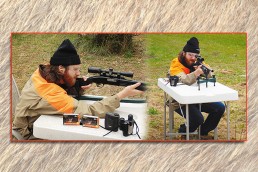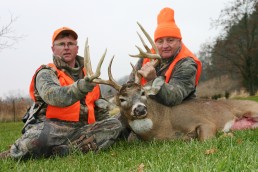Deer Prep: Proper Practice brings Deadly Slug-gun Accuracy
SHARE THIS POST
Today’s shotguns and slugs for hunting big game, especially whitetail deer, deliver performance almost on a par with high-powered rifles. The key word is “almost.”
While slugs can be extremely accurate, they move much more slowly than a rifle bullet, and that has an impact on how you sight your shotgun in for the season.
“You have to pay attention to your setup,” says Brian Smith, a longtime slug hunter from northern Indiana who is marketing director for Lightfield Ammunition, maker of several types of sabot slug loads. “You have to pay attention to how you hold the fore-stock of the shotgun down when you’re sighting in your scope. When you’re in the field you’re not always resting it and you want to make sure you sight your slug gun in by holding it like you’re going to hold it when you take a shot to kill an animal.”
The problem is the powerful recoil of a slow-moving, heavy slug causes the barrel to jump before the projectile is out of the barrel. At the range, this action can be consistent enough that you can get a tight group and think your gun and scope is perfectly accurate. But then you get into the field, hold the barrel down completely, put the crosshairs on the vitals of a deer, squeeze the trigger—and send the slug underneath your target. The barrel didn’t jump.
Smith said the opposite happened to him once when hunting from a blind. After being careful to hold the fore-stock down firmly when sighting the gun at the range, when he readied to shoot a deer from his ground-blind, he rested it on the windowsill. When he shot, the barrel jumped and the slug went over the animal’s back.
The key when sighting the shotgun and then shooting it when afield is to make sure that all of the recoil comes straight back, said Smith. That means holding the front end of the gun down firmly.
“It goes against what a lot of us learned when we first started shooting long guns, and most of us learned with .22s,” Smith said. “We were told we were supposed to relax. With a slug gun you’ve got to hold the forend fairly tightly.”
Knowing the slug’s trajectory is important, too. For example, Smith said one of Lightfield’s most deer-hunting loads popular loads can be sighted in to a tight group at 100 yards. At 50 yards, the slug will be 2-1/2 inches higher.
The trajectory is one reason Smith says slug guns perform better with a good scope, preferably one designed for weapons with the harsher recoil such as a slug gun—scopes designed for .22-caliber rifles probably won’t hold up to the jolt. While open, iron sights work just fine, a scope will deliver better accuracy at longer ranges, too.
Are you enjoying this post?
You can be among the first to get the latest info on where to go, what to use and how to use it!
Smith said hunters should consider getting a “DSG.” That stands for “Designated Slug Gun.” Many popular slug guns come in packages that include a short, rifled barrel for slugs, and a longer smooth-bore barrel for shooting bird shot. Better to have a shotgun that’s dedicated to slug shooting. If you switch barrels, every time you switch back to the slug barrel, you need to re-sight the weapon. The same holds true if you remove the rifled slug barrel to clean the shotgun—you have to get back to the range and make sure the gun can shoot tight groups.
Smith also noted that it’s highly important to sight in—and hunt—with the same brand and load of slugs. Slugs from different companies have different trajectories and performance.
While shotguns with rifled barrels are the best and most accurate when shooting slugs, modern slug designs can work better than passably well when shot through a smoothbore barrel—especially at closer ranges. Smith noted that one of Lightfield’s slugs was developed to meet the criteria of the United States Marine Corp, which wanted a round that could take out a human target at 150 yards—shot from a smoothbore shotgun. He further stated that several companies make screw-in invector chokes with rifling to make slugs spin and improve the projectiles’ downrange accuracy.
The important thing for you to learn is how accurate your shotgun—rifled or smoothbore—is with slugs. That knowledge helps you decide how far away you can expect to shoot and cleanly harvest an animal.
Smith cautioned that first-time slug shooters—especially young hunters—can develop a fear of shooting slugs because of the recoil.
“We’re a big proponent of using the (Caldwell) Lead Sled because the recoil of slugs is greater than normal buck shot and equals that of a high powered rifle,” said Smith, noting that the firing range rifle holder can reduce recoil to almost nothing. He emphasized once again that even with this tool, the shooter must grip the fore-end tightly and hold it down. He said the Lead Sled is great for teaching youths to shoot a slug.
“When you’re helping a young person in slug-gun states, you don’t want them to become afraid of the gun, so use the Lead Sled,” says Smith, who has three daughters who harvested their first deer with slugs before they were teenagers. “When they’re in the field their adrenaline is pumping and they’re excited and they don’t even hear the shot, let alone feel the recoil.”
MWO
SHARE THIS POST
Did you enjoy this post?
You can be among the first to get the latest info on where to go, what to use and how to use it!
Dave Mull
Dave Mull of Paw Paw, Mich. has spent his career communicating the outdoors experience and runs Inner Viking Media. He enjoys kayak fishing for anything that swims in the lakes and rivers of the Midwest and beyond, and even uses his MirroCraft, from time to time. Available for seminars.



